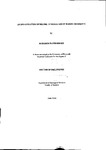AN INVESTIGATION OF SEISMIC ATTENUATION IN MARINE SEDIMENTS
| dc.contributor.author | EDDIES, RODERICK DAVID | |
| dc.contributor.other | School of Geography, Earth and Environmental Sciences | en_US |
| dc.date.accessioned | 2013-10-09T10:21:46Z | |
| dc.date.available | 2013-10-09T10:21:46Z | |
| dc.date.issued | 1994 | |
| dc.identifier | NOT AVAILABLE | en_US |
| dc.identifier.uri | http://hdl.handle.net/10026.1/2109 | |
| dc.description.abstract |
There have been relatively few investigations into the attenuation properties of unconsolidated sediments using marine surface seismic data. Several methods of measuring attenuation were assessed for reliability in a noise-free case and with the addition of noise using a set of synthetically absorbed and dispersed wavelets. Wavelet modelling proved to be superior to the other techniques, followed by spectrum modelling and the spectral ratios method. Complex trace analysis using the analytical signal proved to be unreliable for non-sinusoidal wavelets, whilst the risetime method was found to be very susceptible to noise for practical purposes. Numerical modelling was carried out to assess the spectral effects of layering on a propagating pulse. The thin layer / peg-leg phenomenon has varying filtering effects on the propagating pulse. In particular, layers which are less than the "tuning thickness" of the propagating pulse have a low-pass effect. The quality factor, Q, was measured in two case studies. In the first, the mean Q was determined from wavelet and spectrum modelling and found to be 60 for fine sands and 47 for coarse sands in the 1 kHz to 3 kHz frequency band. In the second, Q was determined as 59 for poorly sorted sandy diamicts in the 100 Hz to 240 Hz frequency band. The close fit between synthesised spectra and wavelets and observed data showed that a constant- Q mechanism would account for the spectral changes between the seabed and the deeper target reflection events in the two case studies. The spectra of the target reflection events in both case studies were lacking in low frequencies which is likely to be due to low-pass filtering from composite reflection events due to thin bed layering. For practical purposes, the determination of Q from a mean normalised seismic trace yielded the same result as measuring a mean Q from individual traces. In a third case study, the seabed multiple was compared to the seabed reflection using wavelet and spectrum modelling. A lack of low frequencies in the seabed multiple showed that the seabed can act as a low-pass filter to an incident pulse. As the numerical methods rely on the seabed as having a white reflection and transmission response, the low-pass effect will result in erroneous estimates of the quality factor, Q. | en_US |
| dc.language.iso | en | en_US |
| dc.publisher | University of Plymouth | en_US |
| dc.title | AN INVESTIGATION OF SEISMIC ATTENUATION IN MARINE SEDIMENTS | en_US |
| dc.type | Thesis | |
| plymouth.version | Full version | en_US |
| dc.identifier.doi | http://dx.doi.org/10.24382/4835 | |
| dc.identifier.doi | http://dx.doi.org/10.24382/4835 |
Files in this item
This item appears in the following Collection(s)
-
01 Research Theses Main Collection
Research Theses Main


